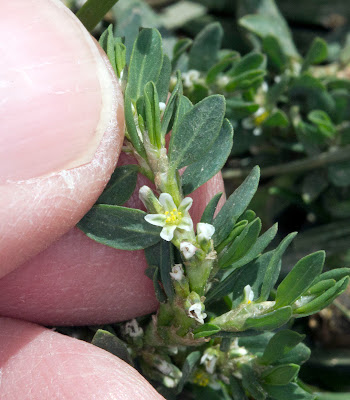 |
| The OFC walking over rolling hills. Orpington Field Club visit to Lullingstone Country Park, 13 August 2011. |
 |
| Knotgrass, Polygonum aviculare. Lullingstone Country Park, 13 August 2011. |
Along the river was an impressive stand of Wild Angelica. Common Blue damselflies moved around in a small clearing nearby, and we saw them now and then all over the meadows we walked through. We also saw a large dragonfly later, patrolling along the edge of a wood; it looked like a Southern Hawker.
The fields were still packed with flowering plants, as all local meadows have been since the Spring. Different types now predominate. No-one was sure of the yellow flower that was everywhere; one of those that look like dandelions but clearly aren't; perhaps it was a Hawk-bit. I need to learn how to distinguish those. But there were many familiar types.
Not wanting to post just a list of plants, I will still name Wild Marjoram, Wild Basil and Wild Thyme. They aren't the same as the culinary herbs, but the Wild Marjoram has a delicious minty scent when a leaf is crushed. But one should not pick wild flowers. It makes a pleasant pink carpet, and butterflies love it.
 |
| Small Heath butterfly, Coenonympha pamphilus Lullingstone Country Park, 13 August 2011. |
We saw several species of butterfly, including swarms of Small Heaths fluttering around each other, and a single, spectacular Brimstone that fluttered around, visible for some while. The Small Heaths, Gatekeepers and Meadow Browns are all clearly related; they look very similar from the side, except for their size.
This was a typical Orpington Field Club outing, quite well attended with 22 pleasant people who moved along in fits and starts and small groups examining interesting plants, birds and insects. You can see some of them spread out in the top photo.
The photos were taken with my EOS 60D and 100mm macro lens, except for the wide scene at the top and the full views of the Wild Angelica and Dark Mullein, which were taken with an Ixus 100.
 |
| Wild Angelica, Angelica sylvestris. Orpington Field Club visit to Lullingstone Country Park, 13 August 2011. |
 |
| Dark Mullein, Verbascum nigrum. Orpington Field Club visit to Lullingstone Country Park, 13 August 2011. |
 |
| Flowers of Dark Mullein, Verbascum nigrum. Orpington Field Club visit to Lullingstone Country Park, 13 August 2011. |
 |
| Common blue damselfly, Enallagma cyathigerum. Female. Lullingstone Country Park, 13 August 2011. |
 |
| Wooden snail statue, probably representing a Roman Snail. We saw one nearby. Orpington Field Club visit to Lullingstone Country Park, 13 August 2011. |
 |
| Common Blue butterfly, Polyommatus icarus, male, on Wild Marjoram, Origanum vulgare. At bottom right, a spray of Red Bartsia, Odontites vernus. Lullingstone Country Park, 13 August 2011. |
Oh, my! This group is really beautiful.
ReplyDelete